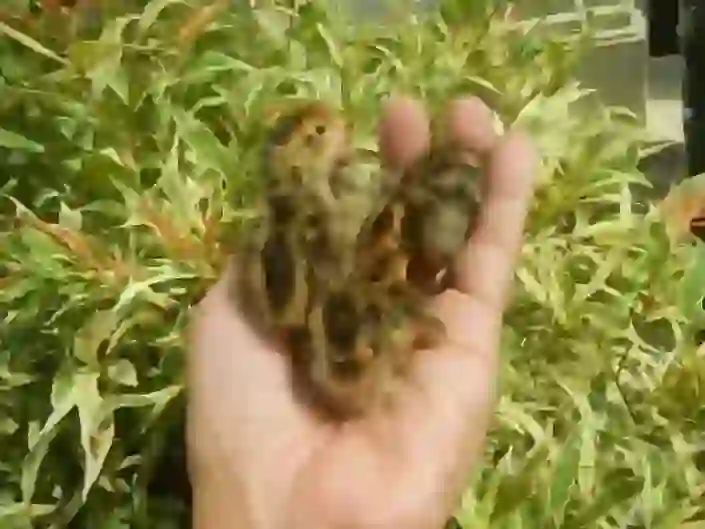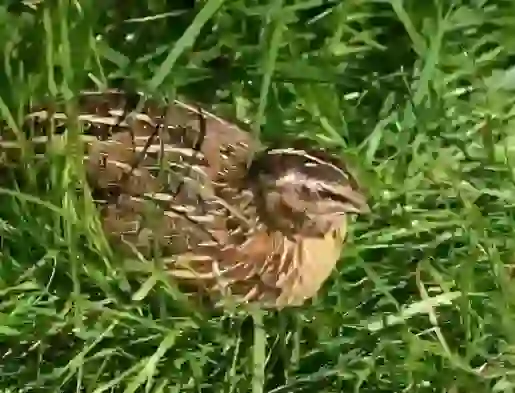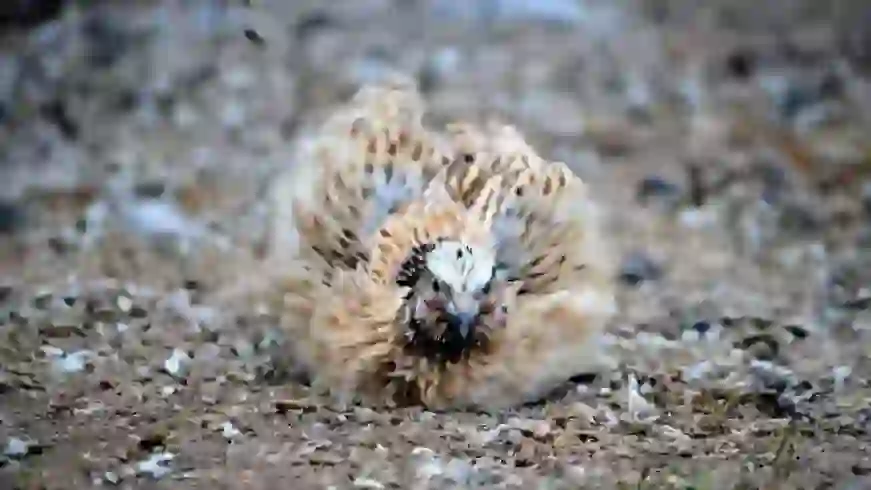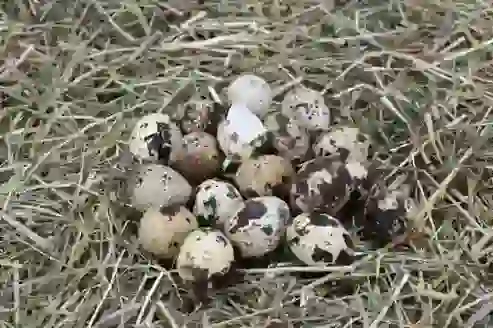
Quail
Quail
Quail
Have you ever seen a small egg in Chinese food or something like that? And do you know the name of the bird that lays its little eggs? Significantly smaller than chicken eggs, these eggs are laid by the bird "quail", which is a member of the pheasant family. Some of you may have seen quail eggs but don't know much about quail, or have never seen them. What features and secrets quails have, let's peek into the quail world together in this article.
Quail Basic Infomation

Aves-Galliformes-Phasianidae.
Length:20cm weight:130~150g.
Quail is a bird of the order pheasant, widely inhabited in the world.
Quails also inhabit Japan, and the quails that inhabit Japan are simply called “quail” or “japanese quail”. The coloration of both males and females is brown on the back feathers and light yellow on the belly feathers. However, males have reddish-brown from their face to their side and a white line above their eyes. Females do not have reddish-brown on their face and have a yellowish line above their eyes.
Quails have small, round bodies, but they are actually migratory birds and are known to fly longer than other pheasants. In Japan, they come as summer birds from central to northern Honshu and Hokkaido or as winter birds from Kanto and Kyushu to the west. Quails that come as summer birds fly to China, the Korean Peninsula, and Indochina in winter.
Quails grow very quickly, and quails raised in captivity reach sexual maturity after about 40-50 days of life and can breed. The breeding season for wild quails is from April to September. When it’s time to lay eggs, females make nests in grassy areas or bushes and lay 5-12 eggs. The eggs hatch in about 16-21 days, and the chicks can fly after about 19 days of life. Only females take care of the chicks; males do not participate in child-rearing.
Quail Q&A

Where did quails get their names?
In English, it is called "quail", but in fact, in the case of the Japanese name, it is named "uzura". Why did it come to be called uzura by its Japanese name this time? We will introduce its origin.
There are various theories about the origin of the name uzura.
According to one theory, in the old Japanese, "u" means grass, and in the old Japanese, "tsura" means to swarm, and it is said that the name uzura was formed by combining these two words.

Why do quails live there?
Quails live in large areas of the world (Asia, Australia, Africa, Oceania, etc.), except for cold regions.
Why quails live all over the world, a clear reason is unknown. However, because they are omnivorous, can eat various things, are hardy and resistant to disease, etc., they may be widely inhabited all over the world.

What do quails eat?
Quails are omnivorous animals and eat grass seeds, cereals, insects, and other things in the wild. In zoos, they are fed quail feed and bird feed, and vegetables such as komatsuna and Chinese cabbage.

What kind of character are quails?
Quails are generally said to be timid.
However, it is said that they often become accustomed to people if they are raised from chicks and treated patiently, such as feeding them by hand. Quails that have become attached to their owners sometimes ask to be petted or played with.

Why do quail eggs have patterns?
It is believed that the reason why quail eggs have patterns is to make them difficult for predators to find by making them the same color as soil.
In fact, quail eggs are originally pure white, but about 1-2 hours before the egg is laid, patterns are printed inside the female quail’s body and laid with patterns. The pattern on quail eggs is a pigment called “porphyrin,” and when soaked in vinegar, the pattern falls off and the original white color of the egg can be seen.
Quail egg patterns are determined individually, and females lay eggs with almost the same pattern throughout their lives. Some quails have no patterns or lay completely white eggs like chickens. Female quails seem to know the pattern of their own eggs and have a habit of laying eggs in places that resemble the pattern of their eggs to protect them from predators.

Is it true that quail eggs sold in stores can hatch?
It's true.
Some quail eggs sold in stores for consumption may contain fertilized eggs. Although the probability of successfully hatching is low due to being for consumption, it is estimated that 2-3 out of 100 eggs will hatch. When hatching quail eggs, it is recommended to use an incubator and have the machine manage temperature, humidity, and egg rotation.
However, if you want to raise quails by hatching eggs, it is recommended that you purchase fertilized eggs from a quail egg producer because it has a higher probability of successfully hatching. It’s not a bad thing to enjoy hatching eggs, but please don’t forget that quails are living creatures and be sure to take responsibility for them after they hatch.

Is it true that quail can be eaten as food?
It's true.
Quails are not only eaten for their eggs but also for their meat.
Quail meat is not a common ingredient that can be found in stores like chicken meat. However, it is a common ingredient in France and has been eaten in Japan for a long time.
The meat is said to have a mild and less distinctive taste, and it is often served as roasted whole or made into minced meatballs with bones and used in soups and stews. Some restaurants serve roasted quail or quail skewers, so those who are interested may want to look for them.
In addition to being eaten by humans, quail meat is also used as food for pet raptors (owls, hawks, etc.).

Is it true that quails are animals related to Japan?
It's true.
There are many animals in the world that have been improved from wild animals for human use and are raised as livestock, such as cows and horses. Quails are also a type of livestock and are said to be the only animal domesticated in Japan.
Quails have been raised since the Muromachi period, and it is said that they were more seriously raised during the Edo period. During this period, quails were kept as ornamental pets for viewing or enjoying their chirping rather than for eating eggs or meat.
At that time, a popular game called “uzura awase” was played in which quails were brought together and their chirping was compared to see which quail could chirp the longest with the best voice.
After that, in the mid-Meiji era, quails began to be raised for the purpose of taking eggs, and now quails are strongly associated with "eggs".

Can quails be kept as pets?
When breeding rare animals at home, it is necessary to follow the established laws in some countries. This time, we will introduce whether quails can be kept at home in Japan.
In conclusion, quails can be kept as pets in Japan. Although quails are not very common pets, they may be available at pet shops if you are lucky.
When keeping quails as pets, it is recommended to choose pet quail feed for their food. Feeds for egg-laying quails or feeds for chickens and pigeons can also be crushed and given to them, but these feeds may be too high in calories for pet quails and may cause obesity.
Quails are classified as “livestock for which hygiene management standards have been established,” such as cows and horses. Therefore, while keeping quails, you are required to report regularly based on the Livestock Infectious Diseases Prevention Law.
Although it may seem a little difficult, you only need to report how many quails you are keeping, so it is not very time-consuming. Since the reporting documents for regular reports differ depending on the prefecture where you live, please check with your nearest city hall or livestock health center for details.

Is it true that quails are surprisingly loud?
It's true.
Quails have a surprisingly loud voice for their small body, and they have a habit of chirping loudly, especially in the early morning.
The daily calls are short calls such as "key-key", "pee-pee", and "cue-cue", but the volume is still loud.
Furthermore, males who have become adults chirp with very harsh voices such as "Kyukke" and "Kyuye", so when breeding in apartment complexes such as condominiums and apartments, it is highly likely that they will become a nuisance to the neighborhood if they do not create soundproof rooms and take measures against squeaking.
By the way, in the Edo period, the quail call sounded like "gokitcho", and it was considered a congratulatory and auspicious bird. Such quails became popular among warlords as a lucky charm, and later spread among ordinary citizens.

Are there places where quails can be seen in Japan?
Quails are kept in many zoos such as Ueno Zoo in Tokyo, Suzaka City Zoo in Nagano Prefecture, and Hiroshima City Asa Zoological Park in Hiroshima Prefecture. Although quails have small bodies and plain colors, you may find new discoveries if you observe them closely.
In addition to zoos, there are tourist farms that offer hands-on experiences with quails.

What is the lifespan of quails?
The lifespan of quails varies depending on the breeding conditions, but the average lifespan of female quails for egg production is less than 2 years and the longest is about 4 years and 6 months.
The number of eggs laid by female quails throughout their lives is said to be an average of 342-384 eggs and up to 630 eggs. Females tend to have a shorter lifespan overall because they use nutrients and energy stored in their bodies such as calcium as they lay more eggs.
In the case of quails kept as pets, they can live for about 5-8 years.

What enemies do quails have?
Wild quails have many natural enemies and can be eaten by birds of prey such as eagles and hawks, carnivores such as weasels, and cats.
In fact, the number of wild quails in Japan is decreasing year by year, and it is classified as “Vulnerable” on the Red List issued by the Ministry of the Environment. Many people feel that they can no longer hear quail chirping in places where they used to hear it. There are concerns that wild quails will become extinct if this continues.
The number of wild quails in Japan is believed to have decreased mainly due to hunting pressure and habitat destruction. Quails were once a representative game animal, but their numbers decreased significantly, and they were excluded from game animals in 2013. They are now protected, so even people with hunting licenses are not allowed to catch them.
We hope that the number of Japanese quails will increase in the future and that they will return to being familiar wild birds as they used to be.

Would you like to become a part of the 'Animalbook.jp'?
Turn your knowledge into Q&A and share it with the world. ※Publication will be activated after purchase. Let's share information together!
Quail Type of List

・Common Quail ・Rain Quail ・Harlequin Quail ・Stubble Quail ・New Zealand Quail(Extinct species)Etc.
Information
Congratulations! You are the first commenter!

Create Your Favorite List!
Quail
Save the animals you love! Build your own list to quickly revisit your favorites later.

Would you like to leave a comment?
※Please note: This is for the purchase of rights to post comments within the article.
Find Your Favorites!
Our shop offers a unique and attractive selection of goods themed around various animals.
Quail References

- 公益信託サントリー世界愛鳥基金「トピックス ウズラ」 http://www.koueki-suntory-aityou.jp/topics/1105.html
- ナショナルジオグラフィック「ウズラ、卵の模様ごとに産卵場所を変更」 https://natgeo.nikkeibp.co.jp/nng/article/news/14/7424/
- 環境省自然環境局「ウズラ調査マニュアル」 https://www.env.go.jp/nature/choju/docs/docs5/docs5-uzura.pdf
- 農林水産省「2章 うずらの生態及び飼養等に関する情報について」 https://www.maff.go.jp/j/syouan/douei/tori/pdf/airepo-2.pdf
- FNNプライムオンライン「スーパーの“ウズラの卵”を温めて孵化させた!? 投稿者「最後まで責任を負う覚悟を」」 https://www.fnn.jp/articles/-/25227
- 鹿児島大学リポジトリ「雌ウズラの寿命と生涯産卵能力について」 https://core.ac.uk/download/pdf/144561421.pdf
- 京都府レッドデータブック「ウズラ」 https://www.pref.kyoto.jp/kankyo/rdb/bio/db/bird0004.html
- 日本テレビ 知識の宝庫!目がテン!ライブラリー「感動 ウズラ ヒヨコ誕生」 https://www.ntv.co.jp/megaten/archive/library/date/05/08/0821.html
- J-STAGE「シリーズ実験動物紹介 ウズラ」 https://www.jstage.jst.go.jp/article/nl2008jsce/43/162/43_125/_pdf/-char/ja
Quail Introduction of media used
出典:https://pixabay.com/videos/id-26316/

出典:https://pixabay.com/images/id-387052/

https://pixabay.com/images/id-2146317/

出典:https://pixabay.com/images/id-2500711/

other
出典:https://pixabay.com/images/id-2107190/

出典:https://pixabay.com/images/id-2393719/

other
出典:https://pixabay.com/images/id-727968/

出典:https://pixabay.com/images/id-213422/

出典:https://commons.wikimedia.org/wiki/File:Japanese_Quail.jpg

出典:https://pixabay.com/images/id-354040/

enemy
出典:https://pixabay.com/images/id-2481852/

enemy
出典:https://pixabay.com/images/id-4758941/

Help Enrich Our Animalbook.jp with Your Media!
We are constantly looking to expand and enrich our Animalbook.jp with amazing photos and videos of animals. If you have any media that you'd like to share, please contribute and help us showcase the beauty and diversity of the animal kingdom. Your submissions will be credited and featured in our encyclopedia, reaching a wide audience of animal lovers.


















